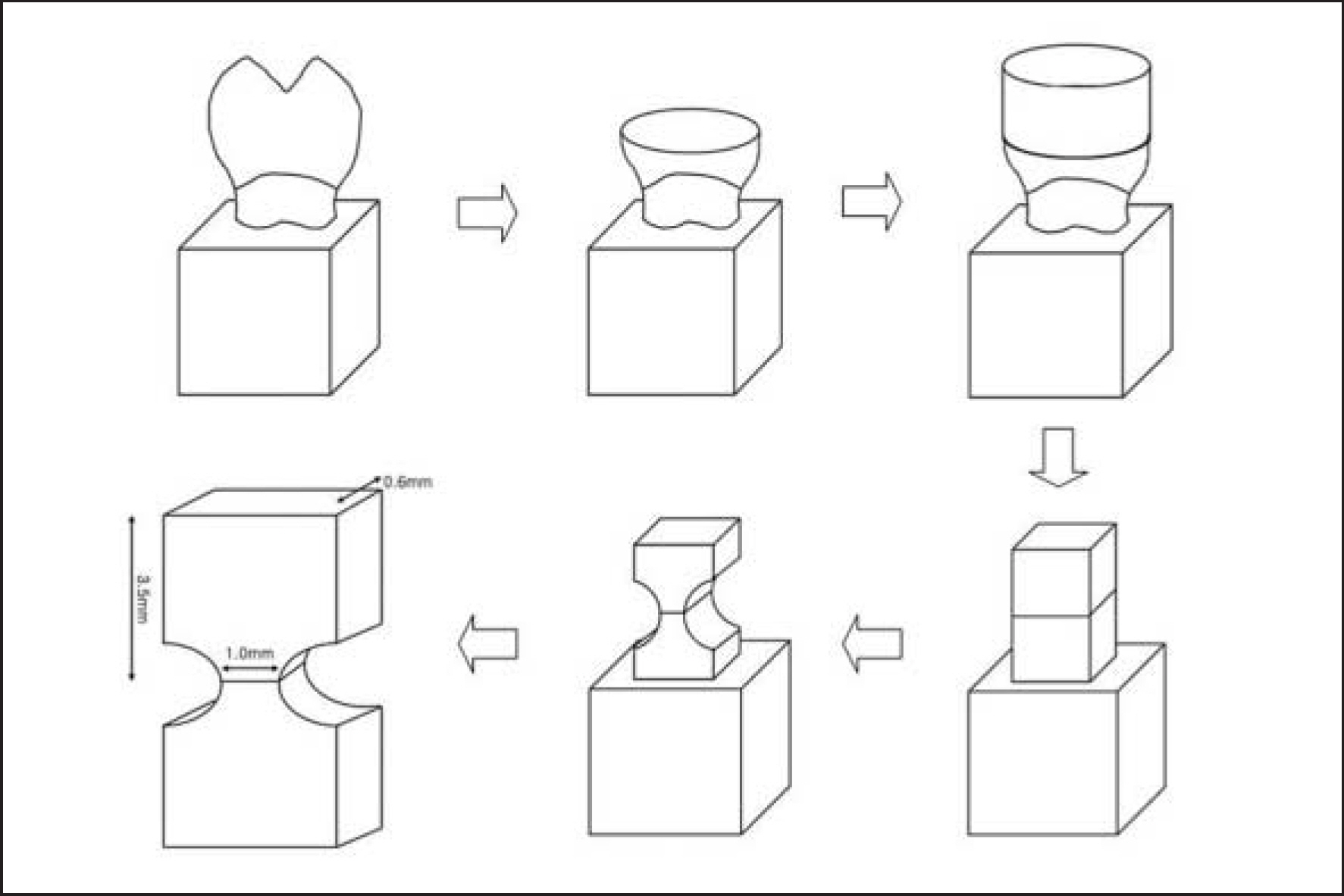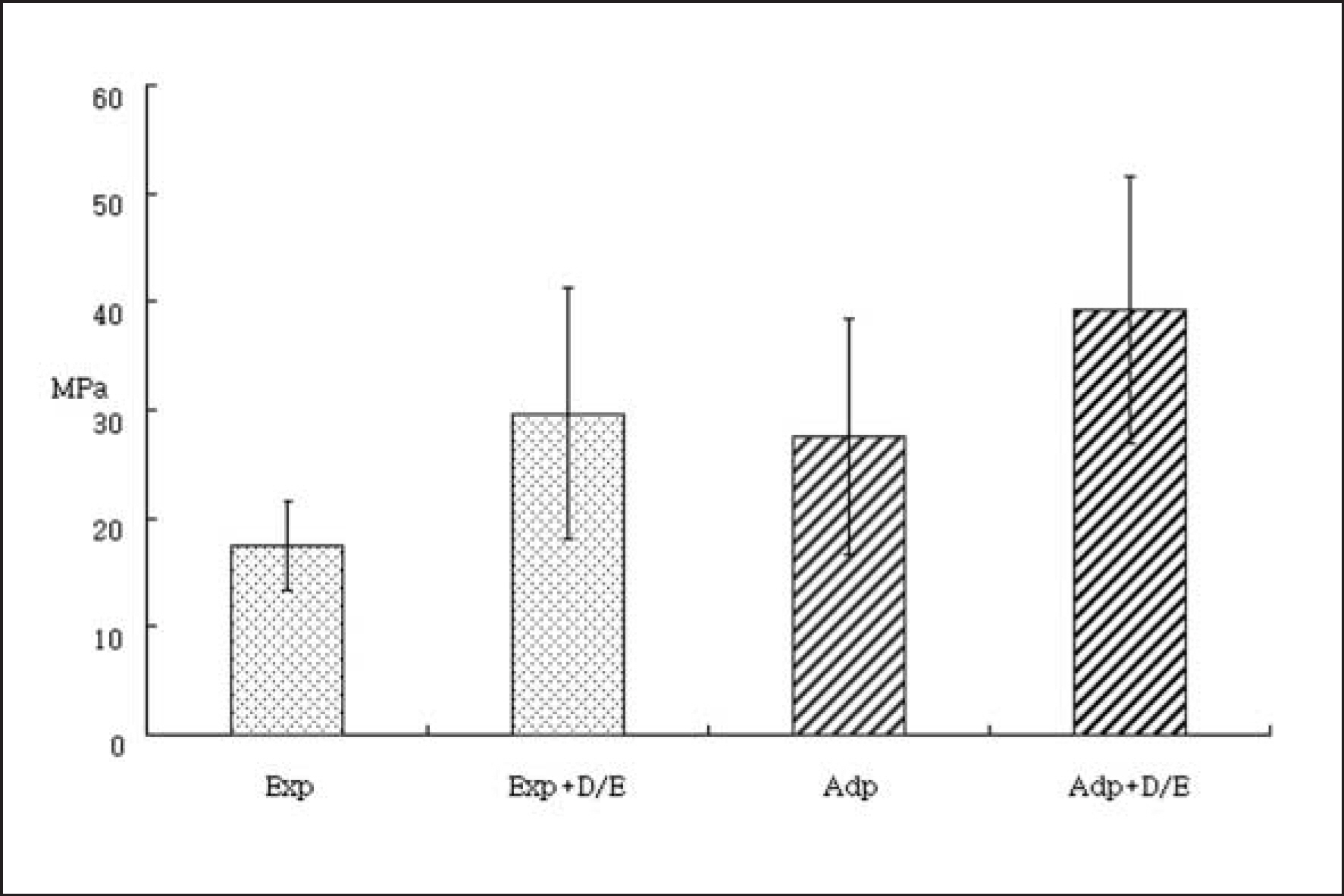J Korean Acad Conserv Dent.
2006 Mar;31(2):103-112. 10.5395/JKACD.2006.31.2.103.
Effect of additional coating of bonding resin on the microtensile bond strength of self-etching adhesives to dentin
- Affiliations
-
- 1Department of Conservative Dentistry, School of Dentistry, Seoul National University, Seoul, Korea. chobh@snu.ac.kr
- 2Dental Research Institute, Seoul National University, Seoul, Korea.
- 3Intellectual Biointerface Engineering Center, Seoul National University, Seoul, Korea.
- KMID: 1986855
- DOI: http://doi.org/10.5395/JKACD.2006.31.2.103
Abstract
- This study investigated the hypothesis that the dentin bond strength of self-etching adhesive (SEA) might be improved by applying additional layer of bonding resin that might alleviate the pH difference between the SEA and the restorative composite resin. Two SEAs were used in this study; Experimental SEA (Exp, pH: 1.96) and Adper Prompt (AP, 3M ESPE, USA, pH: 1.0). In the control groups, they were applied with two sequential coats. In the experimental groups, after applying the first coat of assigned SEAs, the D/E bonding resin of All-Bond 2 (Bisco Inc., USA, pH: 6.9) was applied as the intermediate adhesive. Z-250 (3M ESPE, USA) composite resin was built-up in order to prepare hourglass-shaped specimens. The microtensile bond strength (MTBS) was measured and the effect of the intermediate layer on the bond strength was analyzed for each SEA using t-test. The fracture mode of each specimen was inspected using stereomicroscope and Field Emission Scanning Electron Microscope (FE-SEM). When D/E bonding resin was applied as the second coat, MTBS was significantly higher than that of the control groups. The incidence of the failure between the adhesive and the composite or between the adhesive and dentin decreased and that of the failure within the adhesive layer increased. According to the results, applying the bonding resin of neutral pH can increase the bond strength of SEAs by alleviating the difference in acidity between the SEA and restorative composite resin.
Keyword
Figure
Cited by 2 articles
-
Aging effect on the microtensile bond strength of self-etching adhesives
JS Park, JS Kim, MS Kim, HH Son, HC Kwon, BH Cho
J Korean Acad Conserv Dent. 2006;31(6):415-426. doi: 10.5395/JKACD.2006.31.6.415.Effect of an intermediate bonding resin and flowable resin on the compatibility of two-step total etching adhesives with a self-curing composite resin
Sook-Kyung Choi, Ji-Wan Yum, Hyeon-Cheol Kim, Bock Hur, Jeong-Kil Park
J Korean Acad Conserv Dent. 2009;34(5):397-405. doi: 10.5395/JKACD.2009.34.5.397.
Reference
-
References
1. Fritz UB, Finger WJ. Bonding efficiency of single-bottle enamel/dentin adhesive. Am J Dent. 12:277–282. 1999.2. Bouillaguet S, Gysi P, Wataha JC, Ciucchi B, Cattani M, Godin C, Meyer JM. Bond strength of composite to dentin using conventional, one-step, and self-etching adhesive system. J Dent. 29:55–61. 2001.3. Tomoko A, Shigeru U, Hidehiko S. Comparison of bonding efficacy of an all-in-one adhesive with a self-etching primer system. Eur J Oral Sci. 112:286–292. 2004.
Article4. Pashley EL, Agee KA, Pashley DH, Tay FR. Effects of one versus two application of an unfilled, all-in-one adhesive on dentin bonding. J Dent. 30:83–90. 2002.5. Frankenberger R, Perdigao J, Rosa BT, Lopes M. ‘No-bottle’vs‘multi-bottle’dentin adhesives-a microten-sile bond strength and morphological study. Dent Mater. 17:373–380. 2001.6. Choi KK, Condon JR, Ferracane JL. The effects of adhesive thickness on polymerization contraction stress of composite. J Dent Res. 79:812–817. 2000.
Article7. Cho BH, Dickens SH. Effects of the acetone content of single solution dentin bonding agents on the adhesive layer thickness and the microtensile bond strength. Dent Mater. 20:107–115. 2004.
Article8. Zheng L, Pereira PN, Nakajima M, Sano H, Tagami J. Relationship between adhesive thickness and microten-sile bond strength. Oper Dent. 26:97–104. 2001.9. Chersoni S, Suppa P, Grandini W, Goracci C, Monticelli F, Yiu C, Huang C, Prati C, Breschi L, Ferrari M, Pashley DH, Tay FR. In vivo and in vitro permeability of one-step self-etch adhesives. J Dent Res. 83:459–64. 2004.
Article10. Tay FR, King NM, Suh BI, Pashley DH. Effect of delayed activation of light-cured resin composites on bonding of all-in-one adhesives. J Adhesive Dent. 3:207–225. 2001.11. Tay FR, Pashely DH. Aggressiveness of contemporary self-etching system. I: Depth of penetration beyond dentin smear layers. Dent Mater. 17:296–308. 2001.12. Pashley DH, Sano H, Ciucchi B, Yoshiyama M, Carvalho RM. Adhesion testing of dentin bonding agents: A review. Dent Mater. 11:117–125. 1995.
Article13. Pashley DH, Carvalho RM, Sano H, Nakajima M, Yoshiyama M, Shono Y, Fernandes CA, Tay FR. The microtensile bond test: A review. J Adhesive Dent. 1:299–309. 1999.14. Tay FR, Pashley DH. Water treeing–a potential mechanism for degradation of dentin adhesives. Am J Dent. 16:6–12. 2003.15. Tay FR, Pashley DH, Suh BI, Carvalho RM, Itthagarun A. Single-step adhesives are permeable membranes. J Dent. 30:371–82. 2002.
Article16. Tay FR, Pashley DH, Peters MC. Adhesive permeability affects composite coupling to dentin treated with a self-etch adhesive. Oper Dent. 28:610–621. 2003.17. Simo-Alfonso E, Gelfi C, Sebastiano T, Citterio A, Righetti PG. Novel acrylamido monomers with higher hydrophilicity and improved hydrolytic stability: II. Properties fo N-acryloylaminopropanol. Electrophoresis. 17:732–737. 1996.18. Tay FR, Pashley DH. Have dentin adhesives become too hydrophilic? J Can Dent Assoc. 69:726–731. 2003.19. Hagge MS, Lindemuth JS. Shear bond strength of an autopolymerizing core buildup composite bonded to dentin with 9 dentin adhesive systems. J Prosthet Dent. 86:620–623. 2001.
Article20. Keefe KL, Powers JM. Adhesion of resin composite core materials to dentin. Int J Prosthod. 14:451–456. 2001.21. Swift EJ Jr, Perdigao J, Combe EC, Simpson CH 3rd, Nunes MF. Effects of restorative and adhesive curing methods on dentin bond strengths. Am J Dent. 14:137–40. 2001.22. Sanares AME, King NM, Itthagarun A, Tay FR, Pashley DH. Adverse surface interactions between one-bottle light-cured adhesives and chemical-cured composites. Dent Mater. 17:542–556. 2001.
Article23. Dickens SH, Cho BH. Interpretation of bond failure through conversion and residual solvent measurements and Weibull analyses of flexural and microtensile bond strengths of bonding agents. Dent Mater. 21:354–364. 2005.
Article
- Full Text Links
- Actions
-
Cited
- CITED
-
- Close
- Share
- Similar articles
-
- The effect of bonding resin on bond strength of dual-cure resin cements
- Effect of an intermediate bonding resin and flowable resin on the compatibility of two-step total etching adhesives with a self-curing composite resin
- Influence of application methods of one-step self-etching adhesives on microtensile bond strength
- The influence of cavity configuration on the microtensile bond strength between composite resin and dentin
- The effect of additional etching and curing mechanism of composite resin on the dentin bond strength







